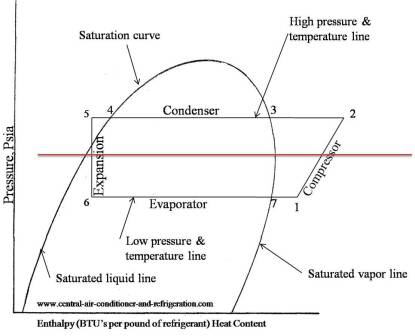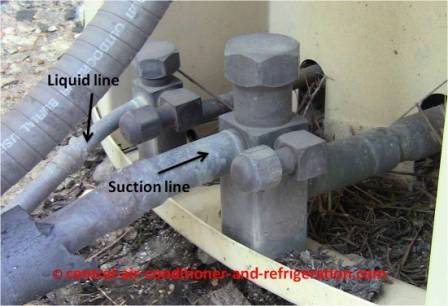|
Refrigeration Cycle Explained in Easy Way
This is a refrigeration cycle diagram of regular central air conditioner units.

All air conditioner units must have the five basic components to work:
We’ll be discussing the ac cycle from split-central air conditioner units perspective; to make it easier. Remember - refrigeration is a process that removes heat from an area that is not wanted and transfers that heat to an area that meaningless. Ok, let get started. In this refrigeration diagram, the four major components split into two sections: Indoor and Outdoor. In indoor units, we have the AC parts number 1 and 2. In outdoor units, we have the AC parts number 3 and 4. These four majors’ components are divided into two difference pressure: high pressure and low pressure. The high pressure side is the condenser units (outdoor) and the low pressure side is the air conditioning evaporator (indoor). The divided point between high and low pressure cut through the compressor and the expansion valve.

Let start with AC parts # 1, Air conditioner evaporator. The air conditioning evaporator is a heat exchanger that absorbs heat into the central air conditioner. The evaporator does not exactly absorb heat! It’s the cooled refrigerant fed from the bottom of the evaporator coils absorb the heat.

The liquid refrigerant usually flows from the bottom of the evaporator coils and boils as it moves to the top of the evaporator coils. The reason it’s fed from the bottom is to ensure the liquid refrigerant boils before it leave the evaporator coils. If a refrigerant was too fed from the top, the liquid refrigerant would easily drop to the bottom of the coils before it absorbs enough heat and boil. If evaporator was to feed liquid refrigerant into air conditioner compressor; it will shorts the air conditioner compressor life. Compressor does not pump liquid. This how air conditioning evaporator boils liquid refrigerant to vapor. A (40°F) refrigerant flows through the evaporator, it absorbs 75°F indoor heat, causing the liquid refrigerant in the evaporator to boils. Side Notes* the temperature of the refrigerant will always try to equalize. The 75°F heat will flow to 40°F refrigerant and it will increases the 40°F temperature and boils it.
After the liquid refrigerant travel across the evaporator coils, the entire liquid refrigerant should have boils. At this point it’s known as saturated vapor point.
The air conditioner evaporator has three important tasks:
Air conditioner parts # 2, Air conditioner compressors. The air conditioning compressor is known as the heart of the central air conditioning units. It’s one of the divided points between high and low side.

As we can see in the refrigeration cycle diagram; the compressor has a refrigerant inlet line and refrigerant outlet line. The compressor inlet lines are known as:
The compressor outlet lines are known as:

The compressor absorbs vapor refrigerant from the suction line and compresses that heat to high superheat vapor. As the refrigerant flows across the compressor, it also removes heat of compression, motor winding heat, mechanical friction, and other heat absorbs in the suction line. The air conditioner compressor produce the pressure different, it’s the compressors that cause the refrigerant to flow in a cycle. Air conditioner parts # 3, Air conditioner condenser . In this refrigeration cycle diagram, the air conditioner condenser is air cooled condenser. It functions the same way as the evaporator but it does the opposite. The condenser units are located outdoor with the compressor. It purposes is to reject both sensible and latent heat of vapor absorb by the air conditioner units.

The condenser receives high pressure and high temperature superheats vapor from the compressor and rejects that heat to the low temperature air. After rejected all the vapor heat, it turns back to liquid refrigerant. The condenser has three important steps:
Air conditioner parts # 4, Air conditioner expansion valve or Thermostatic Expansion Valve (TXV’s) (TEV’s). All expansion device or metering device has similar function (to some extent); it’s responsible for providing the correct amount of refrigerant to the evaporator. This is done by creating a restriction within the thermostatic expansion valve. The restriction causes the pressure and temperature of the refrigerant entering the Evaporator to reduce.

The refrigeration cycle diagram above has a thermostatic expansion valve. This expansion device has
Thermostatic expansion valve has other components besides these three. However, they are not important right now. How does TXV provides the correct amount of refrigerant? TXV provides the correct amount of refrigerant to the evaporator by using a remote sensing bulb as a regulator. The remote sensing bulb and capillary tube has a refrigerant inside. As we can see in the refrigeration cycle diagram above, the remote sensing bulb is tie with the suction line. The temperature from the suction line transfer heat to the sensing bulb through conduction. Sensing bulb responds to the temperature of the suction line and as a result, it decreases or increases the temperature and pressure inside the sensing bulb due to suction line temperatures. The sensing bulb also has a diaphragm on the other end. This diaphragm is with the TXV body. The diaphragm is the device that pushes or releases the needle from the valve seat. There is so much to it, but I hope this explains how expansion device work. Remember* Refrigeration cycle diagram will always have the same basic components (compressor, condenser, expansion device, evaporator, and refrigerant tube.
|




